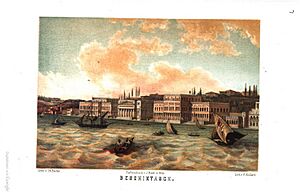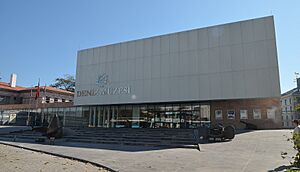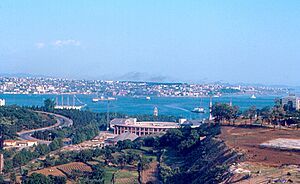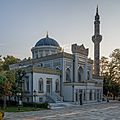Beşiktaş facts for kids
Quick facts for kids
Beşiktaş
|
|
|---|---|
|
Settlement
|
|

Clockwise from top right: Ortaköy Mosque; Arnavutköy; Levent and Etiler; view of Büyükdere Avenue; Akaretler Row Houses; and Dolmabahçe Palace
|
|

Map showing Beşiktaş District in Istanbul Province
|
|
| Country | Turkey |
| Province | Istanbul |
| Area | 18 km2 (7 sq mi) |
| Population
(2022)
|
175,190 |
| • Density | 9,730/km2 (25,200/sq mi) |
| Time zone | TRT (UTC+3) |
| Area code | 0212 |
Beşiktaş (Turkish: [beˈʃiktaʃ]) is a lively district and municipality in Istanbul Province, Turkey. It covers an area of 18 square kilometers and has about 175,190 people living there (as of 2022). This district is located on the European side of the Bosphorus strait, which is a famous waterway.
Beşiktaş is surrounded by other districts: Sarıyer and Şişli to the north, Kağıthane and Şişli to the west, and Beyoğlu to the south. To the east, it faces the Bosphorus, with the district of Üsküdar directly across the water.
This area is home to many important places along the Bosphorus shore. These include the grand Dolmabahçe Palace in the south and the beautiful Bebek area in the north. Beşiktaş also has many well-known neighborhoods further inland, like Levent and Etiler, which are known for being quite fancy. Other famous neighborhoods include Yıldız, Kuruçeşme, Ortaköy, and Arnavutköy.
The historic center of Beşiktaş is the Beşiktaş quarter and Çarşı, which means "marketplace." This area is next to a small park called Abbasağa Park. A major road, Barbaros Boulevard, runs through the district. It connects to the main motorway Otoyol 1 and the Bosphorus Bridge. Another important road, Büyükdere Avenue, also goes through Beşiktaş.
Even though Beşiktaş is a smaller district in Istanbul, it's super important! It has many business and shopping areas, cool historic sites, and famous universities. Plus, it offers amazing views of the Bosphorus strait. The district is also a major financial hub in Turkey.
In 2013, Beşiktaş was ranked as the best district in Turkey. This was because of its high quality of life, how well-off its residents are, and its rich culture. It also ranks first in terms of human development, especially for income and education. The local government is part of the Cities4Europe campaign and has been recognized as a "European 12 Star City."
Contents
What's in the Name?
The district gets its name from the Beşiktaş quarter, which is now part of the Sinanpaşa neighborhood. Locals sometimes call this historic center Köyiçi, meaning "inner village."
The word beşik means "cradle" in Turkish, and taş means "stone."
There are a few stories about how the name came to be:
- One story says there was a Byzantine church in Beşiktaş called Kounopetra, which means "stone cradle" in Greek. This church was built to honor a special stone. This stone was believed to be from the stable in Bethlehem where Jesus was born. Later, the stone was moved to Hagia Sophia but disappeared during the Fourth Crusade.
- Another story suggests that a religious leader from a church in Beşiktaş brought a cradle-shaped stone from a trip to Jerusalem. This stone was supposedly used when Jesus was baptized, and the leader placed it in the church.
- A different idea is that the name comes from beş taş, which means "five stones" in Turkish. This might refer to five stone pillars that Barbarossa Hayreddin Pasha built to tie up ships.
A Look Back in Time
People have lived along the Bosphorus for a very long time, and Beşiktaş has many historic places. It's thought that Constantine the Great settled this area between 306 and 337 CE. This part of the Bosphorus shore is protected from strong winds, making it a great place for ships to dock safely.
In Byzantine times, the area was called Diplokionion, meaning "double pillar" in Greek. This was because of two tall pillars that marked an important entrance from the water into Constantinople. These pillars later inspired the famous twin pillars in Venice.
Long ago, the villages along the Bosphorus were small, separate communities surrounded by forests. The Bosphorus was very important in ancient Greek stories and myths, like the tale of Jason and the Argonauts. During the Byzantine era, churches and a monastery were built here. The Byzantines also started the tradition of having summer palaces on the Bosphorus, like their Ayios Mamas palace. However, these settlements were outside the city walls, so they were often attacked by raiders from the Black Sea. Because of this, not many of the old buildings or statues survived.
When the Ottomans took control of the Black Sea coasts, the Ottoman navy docked in the Bosphorus. This made the Bosphorus villages safe and appealing again. A famous sailor named Barbarossa Hayreddin built his palace and mosque in Beşiktaş, making it his home. By then, Beşiktaş was a key crossing point for traders traveling across Anatolia and along the Silk Road, and for Ottoman armies.
The Ottoman rulers loved this coast and built hunting lodges and grand palaces here. Today, Beşiktaş has some of the most important and magnificent Ottoman buildings. The area saw major events in the late Ottoman period, like changes in leadership at Dolmabahçe Palace in 1876 and Yıldız Palace in 1909.
After the Turkish Republic was founded in 1923, the Ottoman royal family left. The palaces and mansions along the coast became empty. Some were used for new government offices, schools, or other public buildings. Others were unfortunately destroyed.
Today, many people in Beşiktaş believe that the most important person to live there was Zübeyde Hanım, the mother of Mustafa Kemal Atatürk. She lived in the old quarter, right next to the headquarters of Beşiktaş J.K.
Besides the historic areas like Yıldız, Ortaköy, Kuruçeşme, Arnavutköy, and Bebek, many residential areas grew in the district starting around the 1950s. For example, Levent began in the 1950s as a fancy new housing project. The neighborhoods of Etiler, Konaklar, Akatlar, Nisbetiye, Levazım, and Kültür followed soon after.
In 2016 and 2017, there were some unfortunate events in the district. One happened near a stadium and another at a nightclub. The place of the 2016 event is now remembered as the 10 December Martyrs Park.
Weather in Beşiktaş
Beşiktaş has a climate that's a mix of different types, with cool winters and warm to hot summers. It's like a middle ground between the ocean climate to the north and the Mediterranean climate to the south. This means it has a good average of Istanbul's weather.
| Climate data for Kireçburnu, Istanbul (normals 1991–2020, precipitation days and sunshine 1981-2010, snowy days 1996-2011) | |||||||||||||
|---|---|---|---|---|---|---|---|---|---|---|---|---|---|
| Month | Jan | Feb | Mar | Apr | May | Jun | Jul | Aug | Sep | Oct | Nov | Dec | Year |
| Record high °C (°F) | 22.4 (72.3) |
24.6 (76.3) |
29.3 (84.7) |
33.6 (92.5) |
36.4 (97.5) |
40.2 (104.4) |
41.5 (106.7) |
40.5 (104.9) |
39.6 (103.3) |
34.2 (93.6) |
27.8 (82.0) |
25.5 (77.9) |
41.5 (106.7) |
| Mean daily maximum °C (°F) | 8.8 (47.8) |
9.4 (48.9) |
12.0 (53.6) |
16.1 (61.0) |
21.0 (69.8) |
25.7 (78.3) |
28.0 (82.4) |
28.2 (82.8) |
24.6 (76.3) |
19.9 (67.8) |
15.0 (59.0) |
10.7 (51.3) |
18.3 (64.9) |
| Daily mean °C (°F) | 5.9 (42.6) |
6.1 (43.0) |
8.0 (46.4) |
11.5 (52.7) |
16.3 (61.3) |
21.1 (70.0) |
23.7 (74.7) |
24.2 (75.6) |
20.5 (68.9) |
16.2 (61.2) |
11.7 (53.1) |
7.9 (46.2) |
14.4 (58.0) |
| Mean daily minimum °C (°F) | 3.6 (38.5) |
3.5 (38.3) |
4.9 (40.8) |
8.1 (46.6) |
12.8 (55.0) |
17.4 (63.3) |
20.3 (68.5) |
21.2 (70.2) |
17.4 (63.3) |
13.6 (56.5) |
9.2 (48.6) |
5.5 (41.9) |
11.5 (52.6) |
| Record low °C (°F) | −13.9 (7.0) |
−16.1 (3.0) |
−11.1 (12.0) |
−2.0 (28.4) |
1.4 (34.5) |
7.1 (44.8) |
10.5 (50.9) |
10.2 (50.4) |
6.0 (42.8) |
0.6 (33.1) |
−7.2 (19.0) |
−11.5 (11.3) |
−16.1 (3.0) |
| Average precipitation mm (inches) | 96.1 (3.78) |
87.7 (3.45) |
69.8 (2.75) |
45.1 (1.78) |
37.1 (1.46) |
44.7 (1.76) |
36.3 (1.43) |
43.5 (1.71) |
81.3 (3.20) |
98.3 (3.87) |
100.5 (3.96) |
124.8 (4.91) |
865.2 (34.06) |
| Average precipitation days (≥ 0.1 mm) | 16.9 | 15.2 | 13.2 | 10.0 | 7.4 | 7.0 | 4.7 | 5.1 | 8.1 | 12.3 | 13.9 | 17.5 | 131.3 |
| Average snowy days (≥ 0.1 cm) | 4.5 | 4.7 | 2.9 | 0.1 | 0.0 | 0.0 | 0.0 | 0.0 | 0.0 | 0.0 | 0.3 | 2.7 | 15.2 |
| Average relative humidity (%) | 79.8 | 78.6 | 75.8 | 75.1 | 76.5 | 75.7 | 75.3 | 75.9 | 75.0 | 78.4 | 78.9 | 78.4 | 76.9 |
| Mean monthly sunshine hours | 68.2 | 89.6 | 142.6 | 180.0 | 248.0 | 297.6 | 319.3 | 288.3 | 234.0 | 158.1 | 93.0 | 62.0 | 2,180.7 |
| Mean daily sunshine hours | 2.2 | 3.2 | 4.6 | 6.0 | 8.0 | 9.6 | 10.3 | 9.3 | 7.8 | 5.1 | 3.1 | 2.0 | 5.9 |
| Percent possible sunshine | 22 | 29 | 38 | 46 | 57 | 64 | 69 | 66 | 65 | 46 | 31 | 22 | 46 |
Famous Neighborhoods
- Arnavutköy: This neighborhood is between Bebek and Kuruçeşme. It's famous for its many colorful yalıs (waterside mansions) along the coast.
- Aşiyan: You'll find Aşiyan between Bebek and Rumelihisarı. The Turkish poet Tevfik Fikret used to live in a house on the hillside here, which is now a museum. The neighborhood's name means "nest" in Persian, inspired by this house.
- Bebek: The name Bebek means "baby" in Turkish. No one knows exactly why it's called that, but some think it's because the area is "pretty as a baby." Since the 1700s, Bebek has been a wealthy area with beautiful mansions. Today, it's still a very expensive neighborhood full of cafes, restaurants, and shops for Istanbul's elite. It's also known for its delicious badem ezmesi.
- Beşiktaş: This is one of Istanbul's oldest quarters and where the district gets its name. It's a major commercial area in Istanbul, known for its cafes, bakeries, meyhanes (pubs), nightclubs, and fish restaurants. The area is split into Çarşı on the east and Akaretler on the west. Both are part of the Sinanpaşa neighborhood. Çarşı (meaning "marketplace") is home to Beşiktaş Çarşı, Barbaros Square, and the Istanbul Naval Museum.
- Dolmabahçe: Located south of Valideçeşme and north of Kabataş. It's now part of the Vişnezade neighborhood. Its name comes from the famous Dolmabahçe Palace. The BJK Inönü Stadium is also located here.
- Kuruçeşme: This neighborhood is along the Bosphorus and is known for its grand mansions. Many fancy restaurants and clubs are found on its coastline.
- Ortaköy: Today, Ortaköy is famous for its iconic mosque and square. Historically, it was a place where many different cultures lived together. It's also well-known for its tasty kumpir (baked potato with toppings).
- Valideçeşme: This area is right west of Akaretler and is now part of the Vişnezade neighborhood.
- Yıldız: Located east of Barbaros Boulevard. It's home to the Yıldız Palace, which is inside Yıldız Park, one of central Istanbul's largest green spaces. Both Galatasaray University and Yıldız Technical University have their main campuses here. Çırağan Palace and the Kabataş Erkek Lisesi, a very prestigious high school in Turkey, are also in this neighborhood.
Cool Places to Visit
Beşiktaş has many interesting places, both old and new. Some of the most famous are Dolmabahçe Palace, Çırağan Palace, Yıldız Palace, and Ortaköy Mosque.
The Levent neighborhood is home to many modern shopping malls and office buildings. Some of Turkey's tallest buildings are located here, along Büyükdere Avenue.
Historic Spots
- Abbas Ağa Mosque
- Akaretler Row Houses
- Barbarossa Hayreddin Pasha Memorial
- Bebek Mosque
- Çırağan Palace
- Dolmabahçe Palace
- Dolmabahçe Clock Tower
- Esma Sultan Mansion
- Feriye Palace
- Hatice Sultan Palace
- Istanbul Naval Museum
- Ihlamur Palace
- Makruhyan Armenian School
- Malta Kiosk
- Naime Sultan Mansion
- Orhaniye Barracks
- Ortaköy Mosque
- Ortaköy Kethuda Hammam
- Sinan Pasha Mosque
- Tomb of Hayreddin Barbarossa
- Yahya Efendi Lodge
- Yıldız Hamidiye Mosque
- Yıldız Park
- Yıldız Porcelain Factory
- Yıldız Palace
- Yıldız Clock Tower
Modern Landmarks
- Akmerkez
- Istanbul Sapphire
- İş Towers
- Kanyon
- MetroCity
- Sabancı Center
- Vodafone Park
- Zorlu Center
Beşiktaş's Economy
When the Ottoman dynasty moved to Dolmabahçe in the 1600s, many workers settled in Beşiktaş. This led to many shops, like those in Çarşı, opening up. Beşiktaş became an important economic center. However, when the Republic of Turkey was founded and the capital moved to Ankara, Beşiktaş's economic growth slowed down.
In the 1950s, new neighborhoods like Levent and Etiler were built, and Barbaros Boulevard was constructed. The district started to grow again. Transportation improved, and after the Bosphorus Bridge was built in 1973, many businesses and shopping malls appeared. Beşiktaş then became a major business and tourism hub, with skyscrapers and hotels like the Sabancı Center and Isbank Towers.
Beşiktaş is home to the main offices of big Turkish banks like İşbank, Garanti BBVA, Akbank, Yapı Kredi, and Fibabanka. Many countries also have their embassies here, including Azerbaijan, Bulgaria, Denmark, Egypt, Israel, Northern Cyprus, South Africa, Spain, and the United Arab Emirates.
Sports in Beşiktaş
The district gives its name to Turkey's oldest sports club, Beşiktaş Jimnastik Kulübü (Beşiktaş Gymnastics Club), founded in 1903. The club's football team is one of the top three in Turkey. They have won 16 Turkish Super League titles and often play in the UEFA Champions League and Europa League. The team used to play at the historic İnönü Stadium. This stadium was replaced in 2013 by the new 42,590-seat Vodafone Park on the same spot.
The Besiktas Museum, Turkey's largest sports museum, is located inside the stadium. The stadium is near Dolmabahçe Palace, right by the Bosphorus. The football team wears black and white jerseys and is nicknamed the Black Eagles. The club is famous for its loyal fans, who have even set records for the loudest cheers! BJK Akatlar Arena is where the basketball team plays. The club's most famous fan group is called Çarşı.
Besides Beşiktaş JK, the district also has the smaller, historic Ortaköy SK. The Istanbul Specialized Swimming Club was the first swimming club of its kind in the country. There are also other amateur sports clubs and the Levent Tennis Club.
Many of the best sports facilities in the district belong to Beşiktaş JK. These include Vodafone Park, BJK Akatlar Arena, Süleyman Seba Sports Centre, Fulya Training Facilities, and Çilekli Football Field.
Learning and Culture
Beşiktaş is arguably Istanbul's most important center for education. The main campuses of some of Turkey's leading universities are located here. These include Boğaziçi University, Galatasaray University, and Yıldız Technical University. You can also find the Turkish War Academies and parts of Beykent University, Kadir Has University, Istanbul Technical University, and Mimar Sinan Fine Arts University in Beşiktaş.
Many notable primary and secondary schools are in Beşiktaş. These include Robert College, Etiler Anadolu Lisesi, the Istanbul Japanese School, MEF International School, and the Etiler campuses of the British International School Istanbul and Tarabya British Schools. The municipality lists a total of 43 schools for students from kindergarten to 12th grade (K-12), with 12 of them being private.
Museums in the district include the Aşiyan Museum, the Beşiktaş JK Museum, Istanbul Naval Museum, Istanbul State Art and Sculpture Museum, Istanbul City Museum, Yıldız Palace Museum, and the Firefighting Museum.
As of 2018, Beşiktaş has 18 art galleries, 20 libraries, 12 theatre venues, and 8 movie theaters with many screens. There are also other notable performance venues like Kuruçeşme Arena and Zorlu Performing Arts Center.
The Beşiktaş Culture Center, started in 1994 by Yılmaz Erdoğan and Necati Akpınar, is famous across Turkey for its theatre, cinema, and television shows.
-
Yıldız Technical University Faculty of Engineering
-
Robert College, Gould Hall
Getting Around Beşiktaş
Beşiktaş is a major transport hub. You can catch ferries to the Asian side of Istanbul and many buses from here. Ferries go to places like Kadıköy, Eminönü, Üsküdar, Adalar, Sarıyer, and the coastal towns of Beykoz.

Metro Lines
- The M2 metro line runs through Levent and under Büyükdere Avenue to Taksim and Maslak.
- The M6 line is a short line that goes from Levent to Boğaziçi University via Etiler.
- The new M7 line ends at Yıldız, and an extension to Beşiktaş Çarşı is currently being built.
Roads and Bridges
The Boğaziçi Bridge and the Fatih Sultan Mehmet Bridge, which cross the Bosphorus, are located in the district. Both of Istanbul's main ring roads (Otoyol 1 and Otoyol 2) pass through Beşiktaş. Büyükdere Avenue and Barbaros Boulevard are other important main roads.
International Connections
Working with Others
The Beşiktaş municipality is a partner of Eurocities. It takes part in many working groups, from urban aging to migration and integration. It's also part of the Cities4Europe campaign.
Beşiktaş was given the '12 Star City' award in 2016 and 2017 by the Council of Europe.
Twin Cities
Beşiktaş has "twin city" relationships with several places around the world:
 Brooklyn, New York City, United States (since 2005)
Brooklyn, New York City, United States (since 2005) Erlangen, Bavaria, Germany (since 2004)
Erlangen, Bavaria, Germany (since 2004)![link=Dosya:Flag_of_the_Turkish_Republic_of_Northern_Cyprus.svg [tr]](/images/thumb/1/1e/Flag_of_the_Turkish_Republic_of_Northern_Cyprus.svg/23px-Flag_of_the_Turkish_Republic_of_Northern_Cyprus.svg.png) Güzelyurt, Northern Cyprus
Güzelyurt, Northern Cyprus Lewisham, London, United Kingdom
Lewisham, London, United Kingdom Shkodër, Albania
Shkodër, Albania Songpa-gu, Seoul, South Korea
Songpa-gu, Seoul, South Korea Trenčín, Slovakia
Trenčín, Slovakia Xanthi, Greece
Xanthi, Greece
Images for kids
-
Yıldız Porcelain Factory
-
Dolmabahçe Mosque and Dolmabahçe Palace
Video gallery
See also
 In Spanish: Distrito de Beşiktaş para niños
In Spanish: Distrito de Beşiktaş para niños
































